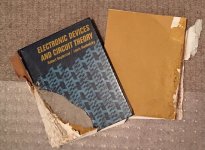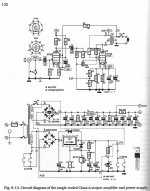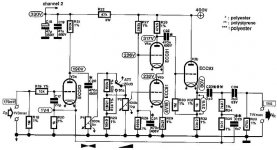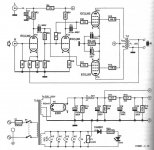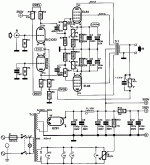Just that the introductions to audio amplifier design that I've seen are written for readers who may not have prior understanding of electronics.
This isn't always the case.
If your recommendation is that Horowitz & Hill is to be avoided as a purchase, what is your recommended alternative?
Unless you have a specific recommendation to make, you're just adding to the noise.
This isn't always the case.
If your recommendation is that Horowitz & Hill is to be avoided as a purchase, what is your recommended alternative?
Unless you have a specific recommendation to make, you're just adding to the noise.
Maybe not, no, no, and maybe. I don't think you've followed what I wrote, but I'll hold back from recommending a textbook on reading
You don't really need to understand amplifiers (supposing anyone understands what's REALLY going on) to build and enjoy one; likewise you don't really need to understand your wife to be happy with your marriage (best if you don't understand her at all).
You must understand what your boss says though.
Best way to learn is to build lots of amps (assuming your mind is able to spot the differences among them) and listen, listen and listen. Every writer is more or less biased. DIY audio is a personal thing. Schematics, you need schematics and a soldering iron.
Indeed, that's also a valid approach. Wouldn't work for me, though. I'd fill up the house with rejected prototypes. The first amps I made are still in daily use.
For starting at ground zero in electronics I've mentioned the ARRL Radio Amateur Handbook or whatever more recent editions are called. More recently I've discovered MAKE: Electronics that's aimed at the current maker/DIY movement. I got a copy to use in teaching electronics at the local hackerspace (this will be an interesting experience). I haven't gone all the way through the book but It's quite experiential and interesting:
Amazon.com: Make: Electronics (Learning by Discovery) (9780596153748): Charles Platt: Books
And of course, for variable quality of the "who knows?" variety but where you're bound to learn something, there's online stuff:
https://www.google.com/search?q=free+electronics+course
Amazon.com: Make: Electronics (Learning by Discovery) (9780596153748): Charles Platt: Books
And of course, for variable quality of the "who knows?" variety but where you're bound to learn something, there's online stuff:
https://www.google.com/search?q=free+electronics+course
Maybe not, no, no, and maybe. I don't think you've followed what I wrote, but I'll hold back from recommending a textbook on reading
No, I understood perfectly what you wrote. You disagreed with the recommendation of Horowitz and Hill and went on to recommend a book recommended two posts previous to your own.
Trying to think back long ago when I was first learning audio electronics and electronics in general, building some of the circuits in the back of the RCA transistor manual brought me a long ways. I think it was a few (10?) watt ac coupled power amp. After that I built some amps from Motorola application notes. Once you've built a few low power things where the cost of failure (in terms of both parts and sparks) is low, confidence is boosted and you can go on to more involved circuits. I built some Heathkits and didn't learn much. I built some Dynakits and maybe learned a bit more, but not nearly so much as scratch building from a schematic.
No, I understood perfectly what you wrote. You disagreed with the recommendation of Horowitz and Hill and went on to recommend a book recommended two posts previous to your own.
No. I suggested that a general textbook might not be the best place to start. It's a straightforward point about the learning process: it's often better to begin at the application end, and work back to the fundamentals on demand.
As for the repetition, it's no great crime. It was overlap, due to writing between Olympic events, if you really need to know. Great minds think alike...and I added a particular reason why the JLH book is useful, and suggested it as supplementary reading. All that for free, and all you can do is grump.
Surely you have something better to do? I have.
No. I suggested that a general textbook might not be the best place to start. It's a straightforward point about the learning process: it's often better to begin at the application end, and work back to the fundamentals on demand.
And to do that you need a source for the basics. Looking at the 5 (2 Douglas Self's, a Bob Cordell and 2 Morgan Jones') audio manuals within easy reach, they're a good starting point for a beginner only insofar as they immediately introduce concepts impenetrable to a beginner without a further reference. You won't make your way through any of these without a grasp of the fundamentals. You could buy all 5 and still end up needing a book on basics.
There's a great deal that has to be absorbed by anyone wanting to do electronics design. It starts with simple 'light-bulb' circuits leading to an appreciation of resistance, voltage and current and expands through Kirchoff's laws to Norton's and Thevenin's theorems followed by electro-magnetics and capacitance before a real-world amplifier can really be appreciated. Some exposure to logarithms, trigonometry, Fourier analysis, real and apparent power and complex numbers helps. Semiconductors, thermionic valves, noise and feedback must also be dealt with along with AC and DC, transformers, rectification and power supplies.
It's difficult to recommend a single book covering all these subjects, a single textbook is barely sufficient to cover magnetics alone.
Different students quite naturally bring varied levels of knowledge and competence of the precursors to the table.
Anyone trying to make a recommendation of a single book as an introduction to audio amplifier design faces an invidious task.
Consequently, when making a recommendation with respect to books to buy when learning about audio amplifiers, it must be said that more than one book will be required. For those already conversant with basic circuit theory a book like Horowitz and Hill offers a path from circuit theory to practical modular design of power supplies, amplifier stages and ancillaries.
At the same time, anyone finding themselves lost when reading this book must come to the realisation that further study of even more basic issues is required.
As for the repetition, it's no great crime. It was overlap, due to writing between Olympic events, if you really need to know.
Pay more attention in future. I don't think it leaves you in a very good position to be making implied criticism of my reading skills.
...all you can do is grump.
Ever a sign of a failing argument when one of the protagonists resorts to the ad hominem.
Surely you have something better to do? I have.
Evidently not.
Another excellent basic (and cheap) text is Malvino's "Electronic Principles", good for picking up basic concepts and doing a little brush-up as well. I picked up my hard back copy for around $5. It had some highlights and marks from a zealous student, but I don't care about that.
The well stocked bookshelf should have H&H, Boylstead's textbook on circuits snippage
Funny you should mention that. I like Boyl[e]stads text on
Electronic Devices Circuit theory too. But don't take our word for it, check out the pic attached as even the late Wanda loved it as well.
R.I.P. Wanda K. Blues Dog (aka gargoyle) 14.7 years living a chocolate labs dream life. Sadly she was ill and ate the spine off the book (horse glue I think). She passed away in my arms at the Vets this last May. Poor gal, had to be carried in. She passed on looking right into my eyes, thanking me for the relief and letting me know that she loved me, her family, my little girl and that she'd be waiting for me on the other
side.
She's in a better place chasing squirrels and retrieving ducks and dummies.
Cheers
Post Script - If anyone has a replacement copy they'd like to donate to the cause, please PM me for address.
Attachments
Walt Jung has lots of stuff on op-amps, including:
"Op Amp Applications Handbook"
Edited by Walt Jung, Published by Newnes/Elsevier, 2005,
Op Amp Applications Handbook, 2005 | Education | Analog Devices
"Op Amp Applications Handbook"
Edited by Walt Jung, Published by Newnes/Elsevier, 2005,
Op Amp Applications Handbook, 2005 | Education | Analog Devices
Copies are inexpensive enough online.Post Script - If anyone has a replacement copy they'd like to donate to the cause, please PM me for address.
BookFinder.com: New & Used Books, Rare Books, Textbooks, Out of Print Books
Best contents is Audio Power Amplifier by Dr. Arto Kolinummi, but too conceptual, no real circuit/schematic example.
Best language for non native English speaker is Designing Audio Power Amplifiers by Bob Cordell. It is easy to understand.
Engineering style is Audio Power Amplifier Design by Douglas Self. Almost everything proved by measurement.
Best language for non native English speaker is Designing Audio Power Amplifiers by Bob Cordell. It is easy to understand.
Engineering style is Audio Power Amplifier Design by Douglas Self. Almost everything proved by measurement.
Warning: avoid the Rainer zur Linde "Build your own Audio Valve Amplifiers".
It's mostly a collection of very mediocre designs published by Elektor, chock full of ridiculous design errors and typos.
My biggest waste of 40 bucks on a book since John Kekes pedantic piffle on moral wisdom.
Cheers,
Glen
Old thread, but here are three examples of those mistakes (btw: I got the book as a present...):
1) The two cathode resistors of 150 Ohm each for the KT88 are connected parallel (also on the design of the circuit board!) giving 75 Ohm, while they should be series connected to give 300 Ohm. Not good for the KT88 at all (and OPT? and power transformer? there's only a fuse on the primary side). It will start to pass way too much current...
2) The cathode of the upper half of the ECC81 sits at 232V, while the filament supply for the tubes is earthed, so sits at 0V (not shown in the schematic but it does). The maximum cathode to heater voltage of the ECC81 is 90V. Not good for the cathode/filament isolation; very high risk on it failing...
3) The reservoir capacitor of 100 uF is connected straight to the EZ81, without even any protecting resistors in the anode leads and/or in the cathode lead. The maximum value of this reservoir capacitor is 50 uF in the datasheets of the EZ81. Not good for the cathode of the EZ81...
Addition: I did write to the publisher (in 2010) about these mistakes, and they aknowledged them. But as far as I know, they still sell this book without warning buyers for the mistakes it contains.
Attachments
Last edited:
One more example from the book "Build your own Audio Valve Amplifiers" by Rainer zur Linde with multiple mistakes (btw: the values of the parts in the schematic match the values in the parts list in the book).
Pre-stage/phase splitter:
What are we looking at? At first glance it looks like a long-tail pair but the ‘tail’ is very short and the values of the anode resistors (100K and 15K) differ enormously. The resistor of 15K is at the anode of the triode with the grounded grid (well, grounded through a 1M resistor bypassed by a 2.2 uF capacitor...), while normaly you see the higher valued anode resistor at this side.
I do not see how this design can produce output voltages of the same amplitude but with opposite phase. I think that the side with 15K will produce way less amplitude than the side with 100K.
The feedback looks strange to me since it is applied to the common ‘tail’. A member of an other forum wrote this about it: "Effectively the feedback signal modulates the Gm the forwards path experiences.... it's a frequency mixer! Should help make even order distortion quite nicely. If only the author had known it could have been patented as a "valve sound enhancer"
Between B = 283 V and the top of R3 the voltage difference is 55 V. Even with the slider of P1 turned fully downwards (which by the way would be impossible because there has to be only 260 V at R4) you would still need a current of: I = V / R = 55 / 25000 = 2.2 mA.
But there is no 2.2 mA to start with when looking at the cathode voltage and cathode resistors. I = V / R = 2.2 / 1247 = 1.76 mA.
So however this stage is supposed to work, it can surely not work with the given values/voltages.
Output stage:
In the schematic (and in the text) it says that you have to adjust the cathode resistance so that the anode current per EL84 is 44 mA. The cathode voltage would than be about 8 V.
Let's suppose that the dc resistance per half of the primary is about 200 Ohm (wich is rather high for an output transformer of quality). Than the voltage loss in one half of the primary would be about 10 V. So the voltage between cathode and anode of the EL84’s is 300 – (8 + 10) = 282 V. The voltage between the cathode and screen grid will be slightly higher, lets say 285 V.
Looking in the datasheets for the EL84 you will see that it is impossible that the anode current is only 44 mA at Vg1 = -8 V and Vg2 = 285 V. I think something between 60 and 65 mA is right. But than the anode dissipation per EL84 would be between 17 and 18.4 Watt, which ofcourse is way over the limit of 12 Watt.
Power supply:
It is impossible to get 300 Vdc from 2 x 200…220 Vac and an EZ81 at about 100 mA like this amplifier is supposed to draw. I do not think you will even reach 250 Vdc.
The value of C8 right after the EZ81 is 100 uF. The datasheets give 50 uF as maximum. Higher values at least shorten lifespan.
The cathode of the EZ81 is connected to its filament, which in turn is connected to the filaments of the other tubes. The filaments are grounded through anti-hum pot P5, so B+ is practically shorted to ground.
Pre-stage/phase splitter:
What are we looking at? At first glance it looks like a long-tail pair but the ‘tail’ is very short and the values of the anode resistors (100K and 15K) differ enormously. The resistor of 15K is at the anode of the triode with the grounded grid (well, grounded through a 1M resistor bypassed by a 2.2 uF capacitor...), while normaly you see the higher valued anode resistor at this side.
I do not see how this design can produce output voltages of the same amplitude but with opposite phase. I think that the side with 15K will produce way less amplitude than the side with 100K.
The feedback looks strange to me since it is applied to the common ‘tail’. A member of an other forum wrote this about it: "Effectively the feedback signal modulates the Gm the forwards path experiences.... it's a frequency mixer! Should help make even order distortion quite nicely. If only the author had known it could have been patented as a "valve sound enhancer"
Between B = 283 V and the top of R3 the voltage difference is 55 V. Even with the slider of P1 turned fully downwards (which by the way would be impossible because there has to be only 260 V at R4) you would still need a current of: I = V / R = 55 / 25000 = 2.2 mA.
But there is no 2.2 mA to start with when looking at the cathode voltage and cathode resistors. I = V / R = 2.2 / 1247 = 1.76 mA.
So however this stage is supposed to work, it can surely not work with the given values/voltages.
Output stage:
In the schematic (and in the text) it says that you have to adjust the cathode resistance so that the anode current per EL84 is 44 mA. The cathode voltage would than be about 8 V.
Let's suppose that the dc resistance per half of the primary is about 200 Ohm (wich is rather high for an output transformer of quality). Than the voltage loss in one half of the primary would be about 10 V. So the voltage between cathode and anode of the EL84’s is 300 – (8 + 10) = 282 V. The voltage between the cathode and screen grid will be slightly higher, lets say 285 V.
Looking in the datasheets for the EL84 you will see that it is impossible that the anode current is only 44 mA at Vg1 = -8 V and Vg2 = 285 V. I think something between 60 and 65 mA is right. But than the anode dissipation per EL84 would be between 17 and 18.4 Watt, which ofcourse is way over the limit of 12 Watt.
Power supply:
It is impossible to get 300 Vdc from 2 x 200…220 Vac and an EZ81 at about 100 mA like this amplifier is supposed to draw. I do not think you will even reach 250 Vdc.
The value of C8 right after the EZ81 is 100 uF. The datasheets give 50 uF as maximum. Higher values at least shorten lifespan.
The cathode of the EZ81 is connected to its filament, which in turn is connected to the filaments of the other tubes. The filaments are grounded through anti-hum pot P5, so B+ is practically shorted to ground.
Attachments
Last edited:
Bob Cordell's "Designing Audio Power Amplifiers" 2nd Edition is the best for my money. When Bob's new book is out I will be getting that one right away. He is a solid author who can speak well to both seasoned EE's and experimenters alike. But if you are looking for a formal academic textbook treatment of BJT/MOS IC amplifiers my favorite is the classic "Analysis and Design of Analog Integrated Circuits" Gray / Meyers (U.C. Berkeley). Gray / Meyer derives bias, sectional gain and BW as well as showing the very-useful approximations for both BJT and MOS. Every topic in the book (among these DiffAmp, VAS, Compensation, Output stage) have both BJT and MOS equations throughout the book! Is there another book that does that? These old artifacts are still retained making this book still valuable today.
What book is that?When Bob's new book is out I will be getting that one right away.
- Home
- General Interest
- Everything Else
- best audio amplifier book??
